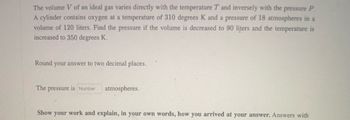
College Physics
11th Edition
ISBN: 9781305952300
Author: Raymond A. Serway, Chris Vuille
Publisher: Cengage Learning
expand_more
expand_more
format_list_bulleted
Concept explainers
Question

Transcribed Image Text:The volume V of an ideal gas varies directly with the temperature T and inversely with the pressure P.
A cylinder contains oxygen at a temperature of 310 degrees K and a pressure of 18 atmospheres in a
volume of 120 liters. Find the pressure if the volume is decreased to 90 liters and the temperature is
increased to 350 degrees K.
Round your answer to two decimal places.
The pressure is Number
atmospheres.
Show your work and explain, in your own words, how you arrived at your answer. Answers with
Expert Solution
This question has been solved!
Explore an expertly crafted, step-by-step solution for a thorough understanding of key concepts.
This is a popular solution
Trending nowThis is a popular solution!
Step by stepSolved in 2 steps with 1 images

Knowledge Booster
Learn more about
Need a deep-dive on the concept behind this application? Look no further. Learn more about this topic, physics and related others by exploring similar questions and additional content below.Similar questions
- Please help me with this question and explain it. Thank you!arrow_forwardIf a 5 m3 of gas initially at STP is placed under a pressure of 3 atm, the temperature of the gas rises to 17◦C. What is the volume now? Calculate to 2 decimals.arrow_forwardAn atom of neon has a radius Ne-38. pm and an average speed in the gas phase at 25°C of 350.m/s. Suppose the speed of a neon atom at 25°C has been measured to within 0.10%. Calculate the smallest possible length of box inside of which the atom could be known to be located with certainty. Write your answer as a multiple of "Ne and round it to 2 significant figures. For example, if the smallest box the atom could be in turns out to be 42.0 times the radius of an atom of neon, you would enter "42.Ne" as your answer. [arrow_forward
- A modern-day zeppelin holds 9,480 m3 of helium. Compute its maximum payload at sea level. (Assume the helium and air to be at 0°C and 1 atm.)Answer in Narrow_forwardThe pressure, volume, and temperature of a mole of an ideal gas are related by the equation PV = 8.31T, where P is measured in kilopascals, V in liters, and T in kelvins. Use differentials to find the approximate change in the pressure if the volume increases from 10 L to 10.6 L and the temperature decreases from 335 K to 330 K. (Note whether the change is positive or negative in your answer. I Round your answer to ti decimal places.arrow_forwardTwo containers of equal volume each hold samples of the same ideal gas. Container A has 2 times as many molecules as container B. If the gas pressure is the same in the two containers, find the ratio of the the absolute temperatures TA and TB ( i.e TA / TB ) . Calculate to 2 decimals.arrow_forward
- A container of gas holds 0.74 moles of neon gas. If the volume of the container is 11.8 liters and the pressure inside is 1.97 atm, what is the temperature (in K) of the gas?arrow_forwardThe pressure P (in kilopascals), volume V (in liters), and temperature T (in kelvins) of a mole of an ideal gas are related by the equation PV = 8.317. Find the rate at which the volume is changing when the temperature is 325 K and increasing at a rate of 0.05 K/s and the pressure is 29 and increasing at a rate of 0.07 kPa/s. Please show your answers to at least 4 decimal places. dV dt L/sarrow_forwardAccording to the Ideal Gas Law, PV = kT, where P is pressure, Vis volume, T is temperature (in Kelvins), and k is a constant of proportionality. A tank contains 2000 cubic inches of nitrogen at a pressure of 26 pounds per square inch and a temperature of 600 K. Determine the EXACT value of k.arrow_forward
- If a 3 m3 of gas initially at STP is placed under a pressure of 2 atm, the temperature of the gas rises to 22◦C. What is the volume now? Calculate to 2 decimals.arrow_forwardIf a 2 m3 of gas initially at STP is placed under a pressure of 2 atm, the temperature of the gas rises to 63◦C. What is the volume now? Calculate to 2 decimals.arrow_forward
arrow_back_ios
arrow_forward_ios
Recommended textbooks for you
 College PhysicsPhysicsISBN:9781305952300Author:Raymond A. Serway, Chris VuillePublisher:Cengage Learning
College PhysicsPhysicsISBN:9781305952300Author:Raymond A. Serway, Chris VuillePublisher:Cengage Learning University Physics (14th Edition)PhysicsISBN:9780133969290Author:Hugh D. Young, Roger A. FreedmanPublisher:PEARSON
University Physics (14th Edition)PhysicsISBN:9780133969290Author:Hugh D. Young, Roger A. FreedmanPublisher:PEARSON Introduction To Quantum MechanicsPhysicsISBN:9781107189638Author:Griffiths, David J., Schroeter, Darrell F.Publisher:Cambridge University Press
Introduction To Quantum MechanicsPhysicsISBN:9781107189638Author:Griffiths, David J., Schroeter, Darrell F.Publisher:Cambridge University Press Physics for Scientists and EngineersPhysicsISBN:9781337553278Author:Raymond A. Serway, John W. JewettPublisher:Cengage Learning
Physics for Scientists and EngineersPhysicsISBN:9781337553278Author:Raymond A. Serway, John W. JewettPublisher:Cengage Learning Lecture- Tutorials for Introductory AstronomyPhysicsISBN:9780321820464Author:Edward E. Prather, Tim P. Slater, Jeff P. Adams, Gina BrissendenPublisher:Addison-Wesley
Lecture- Tutorials for Introductory AstronomyPhysicsISBN:9780321820464Author:Edward E. Prather, Tim P. Slater, Jeff P. Adams, Gina BrissendenPublisher:Addison-Wesley College Physics: A Strategic Approach (4th Editio...PhysicsISBN:9780134609034Author:Randall D. Knight (Professor Emeritus), Brian Jones, Stuart FieldPublisher:PEARSON
College Physics: A Strategic Approach (4th Editio...PhysicsISBN:9780134609034Author:Randall D. Knight (Professor Emeritus), Brian Jones, Stuart FieldPublisher:PEARSON

College Physics
Physics
ISBN:9781305952300
Author:Raymond A. Serway, Chris Vuille
Publisher:Cengage Learning

University Physics (14th Edition)
Physics
ISBN:9780133969290
Author:Hugh D. Young, Roger A. Freedman
Publisher:PEARSON

Introduction To Quantum Mechanics
Physics
ISBN:9781107189638
Author:Griffiths, David J., Schroeter, Darrell F.
Publisher:Cambridge University Press

Physics for Scientists and Engineers
Physics
ISBN:9781337553278
Author:Raymond A. Serway, John W. Jewett
Publisher:Cengage Learning

Lecture- Tutorials for Introductory Astronomy
Physics
ISBN:9780321820464
Author:Edward E. Prather, Tim P. Slater, Jeff P. Adams, Gina Brissenden
Publisher:Addison-Wesley

College Physics: A Strategic Approach (4th Editio...
Physics
ISBN:9780134609034
Author:Randall D. Knight (Professor Emeritus), Brian Jones, Stuart Field
Publisher:PEARSON